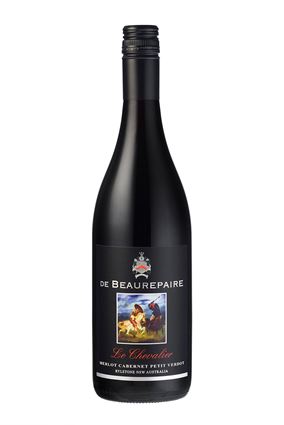Heritage Collection
2022 Patte Bleu Pinot Gris
290 CASES PRODUCED
Description
Our Pinot Gris is not to be confused with the high yielding, high acidity, cheap and cheerful Pinot Grigio school, originating in Veneto and Friuli. Our intention was to produce a mid-slope, Alsatian-style Pinot Gris – a rich, complex, textural aromatic wine – designed to age, match with food and produce a medium bodied wine. We decided to also leave the grapes on the skins to extract additional aromas and flavours, together with a little tannin to give our interpretation of a dry, aromatic mid-slope Alsatian Pinot Gris.
Heritage
‘Patte Bleu’ is slang for the blue feet of the chickens from around our family’s hometown in Burgundy – Beaurepaire-en-Bresse. These chickens are appellation controlled and called Poulet de Bresse. They’re famous not just for the quality of their meat which is sought after by many chefs, but also for their red plume, white feathers and blue legs – making them quite literally France’s chicken. Our 700 year old ancestral family home in Bresse, still occupied by the family, lies just east of Beaune – the capital of Burgundy’s wine industry.
Terroir
The vineyard is located above Rylstone in the Central Ranges GI of NSW (40km southeast of Mudgee, 70km northeast of Bathurst). It was planted in 1998 by Richard & Janet de Beaurepaire, with a mixture of Bordeaux, Rhône, and Burgundy varieties with the intention of selling most of the grapes whilst organically growing wine production. The decision to plant the vineyard at this location over other established winegrowing regions (including family winemaking operations in the Yarra Valley) was due to the similarity of the terroir to Burgundy – the home of the de Beaurepaire family. The vineyard is in a mountain valley, 150 kilometres from the coast in the Great Dividing Range. It is planted on North facing slopes rising from the Cudgegong River to an altitude of 650m. Geologically, the vineyard is planted on an Ordovician-era (450 MY ago) coral reef with shallow sandy and sandy-loam soils on limestone. The limestone was mined nearby until recently by Kandos Cement. The altitude, distance from ocean and poor heat retention of the soil and limestone, creates an inland continental climate as cool as Central Otago in New Zealand and Tasmania in Australia during the growing season with extreme diurnal variation – late Sept/Oct Budburst, Jan/Feb Veraison and March/April Harvest.
Vineyard
Vintage Conditions: A relatively cool vintage with decent rainfall. Some early frosts reduced yields in early budburst varieties. The summer was relatively cool, with rainfall ensuring very active canopy management to mitigate disease risks. Another great year for acidity.
Harvest (yield): Machine harvested on the evening of 11 March with a baumé of 13 and pH of 3.35. Yield was approximately 3.5 tonnes per hectare (~20 hl/ha). Sourced from A Block (clone D1V7), with an average vine age of 21 years. The soils are very shallow (down to 30cm in spots), predominantly free-flowing sand with a little clay over limestone bedrock with a moderate slope.
Vinification
Crushed and destemmed and then left on skins for 4 hours before being very gently pressed over 5 hours.
Pressing was very slow and gentle on the destemmed fruit. Juices from the last pressing were not retained. Fermentation started cool (16 degrees) and was undertaken using native (“wild”) yeasts. Once fermentation was 90% complete it was transferred to stainless-steel tanks. Limited malolactic conversion. Not fined. Vegan.
Aging
Kept on lees in steel tanks for 9 months on lees with limited battonage.
Analysis: pH 3.35, TA 5.5g/l, RS 2g/l
Tasting Notes
Aromas of pears and quince, hints of honeysuckle and gingerbread. Fresh citrus and ripe pear with very lightly smoked earthy notes (truffles and funghi) bouquet. Great length and mouthfeel, gentle tannins from the skin contact and dry.
Vin et Gastronomie
Seared or grilled meaty fish or shellfish served in sauce or cream; Asian wok-fried style vegetables and chicken with a sweet and sour or spicy sauce or Indian curries and dahl. Veal blanquette or Mushroom risotto, terrines and foie gras. Pungent, washed-rind cheeses.
Wine Tips
Cellaring Potential: 10 years.
Serving Temperature: 8 degrees C / 46 degrees F
| $40.00 |
Le Chevalier Merlot-Cabernet Petit Verdot
Cases produced - 944
Description
Terroir
The de Beaurepaire family’s estate is in the valley above Rylstone in the Central Ranges (GI) of NSW. The vineyard is located on an ancient coral reef located just off the shore of Gondwana (450MYO) which formed a band of limestone (Coomber Formation) running north/south that appears in valleys where the younger Rylstone volcanic rock has been eroded away. 55 hectares of vines were planted in 1998. The vineyard is 150km inland and 580-650m altitude with a North-East aspect. Soil structure is shallow (<1m) sandy-loam mixed with limestone; the temperature range is as cool as Tasmania and Central Otago through the growing season; and the climate is inland/continental (large day/night variation) creating a terroir similar to Burgundy (the ancestral home of the de Beaurepaire family for nearly 1,000 years). The temperature range is very similar to Burgundy – during the growing season (October-April), our low/high/average of 11.9 / 21.7 / 16.9 degrees Celsius vs Beaune (Burgundy) low/high/average of 11.9 / 23.3 /17.6 degrees Celsius.
Vineyard
Sourced from C Block (Cabernet and Petit Verdot) and B Block (Merlot) with an average vine age of 15 years.
Harvest: Machine harvested on 14 April 2019 (Merlot), 23 April (Cabernet) and 16 April (Petit Verdot) with an average baumé of 15.0. Average yield – 7t/ha (~45hl/ha).
Vintage Conditions: 2019 started as the driest vintage on record for our vineyard with reduced production in early ripening varieties and sparkling base (chardonnay and pinot noir). Torrential rain at the start of March slowed down the baumé (sugar) accumulation/ripening enabling the phenolic (flavour) ripeness to catch up producing some lush, rounded flavours for red varieties.
Vinification
Very gentle press cycle to limit over-extraction of tannins and maximize free run juice in wine.
Fermentation occurred in a combination of stainless tanks and a mixture of old and new French oak barrels for 10 days.
Not fined. Not filtered. To maximise aromatic profile and flavour profile. Vegan Friendly
Analysis: pH: 3.32; TA: 7.2, VA : 0.48, R/S : 0.77
Aging
Aged for 14 Months in 30% new and 70% 1 to 3-year-old French (Seguin Moreau) Hogsheads
Tasting Notes
The colour is a vibrant red with purple hues and displays ripe red berry and blackcurrant aromas. The palate is long with berry, chocolate and spice characters with integrated French oak, and has a soft, ripe, balanced tannin finish.
Vin et Gastronomie
This wine is well suited to classic beef, game or lamb roasts, or stews, Think grilled and roast lamb (Pauillac Lamb if you can source it!) with garlic and rosemary, filet mignon and mushrooms braised in a whisky pan sauce or beef daubes and other stews. Stronger cheeses like Roquefort, Camembert and Brie or hard British territorial cheeses such as Cheshire and red Leicester work well with the tannins. For vegetarians and vegans, think the dark flavours of roasted mushrooms, dried cranberries in spinach salad or tossed with charred Brussel sprouts, or perhaps roasting cauliflowers with a rub of sumac or za-atar or a hint of turmeric with roasted root veggies. Umami flavours in soy are another option and leverage the healthy fats in avocados.
Wine Tips
Cellaring Potential: 15 years
Serving Temperature: 16 to 18 degrees C / 61 to 65 degrees F
| $35.00 |
Perceval Pinot Noir
560 cases produced
Description
The 2022 ‘Perceval’ is crafted from four selected clones of our Pinot Noir grapes from 21 and 23 year old vines (clones: 35% 777, 30% MV6, 24% 114 and 11% 115) from our 55-hectare single-estate vineyard to produce a classic medium bodied, cool-continental climate Pinot Noir. The wine has been unfiltered and unfined to protect phenolic flavours and aromas.
Perceval takes its name from the 12th century legend, Le Conte du Graal, written by Chrétien de Troyes, whilst at the court of Marie of Champagne. In the story the young Knight Perceval seeks the Fisher King. On his quest, he comes across a ‘Damsel in Distress’ (Blanchefleur) whose castle (Chateau Beaurepaire) is under siege. After meeting Blanchefleur, he falls in love with her, becomes her champion and lifts the siege. The story of Blanchefleur and Perceval was the first medieval romance and first written account of the quest for the Holy Grail – a name often ascribed to the drive to produce a great Pinot!
Terroir
The de Beaurepaire family’s estate is in the valley above Rylstone in the Central Ranges (GI) of NSW. The vineyard is located on an ancient coral reef located just off the shore of Gondwana (450MYO) which formed a band of limestone (Coomber Formation) running north/south that appears in valleys where the younger Rylstone volcanic rock has been eroded away. 55 hectares of vines were planted in 1998. The vineyard is 150km inland and 580-650m altitude with a North-East aspect. Soil structure is shallow (<1m) sandy-loam mixed with limestone; the temperature range is as cool as Tasmania and Central Otago through the growing season; and the climate is inland/continental (large day/night variation) creating a terroir similar to Burgundy (the ancestral home of the de Beaurepaire family for nearly 1,000 years). The temperature range is very similar to Burgundy – during the growing season (October-April), our low/high/average of 11.9 / 21.7 / 16.9 degrees Celsius vs Beaune (Burgundy) low/high/average of 11.9 / 23.3 /17.6 degrees Celsius.
Vineyard
Pinot Noir sourced from A Block (clones: 24% 114, 11% 115 and 35% 777) from 24-year-old vines and from C Block (clone: 30% MV6) with 22-year-old vines.
Harvest (yield): Machine harvested on the evenings of 11, 15 and 17 March. An average yield of 4 tonnes per hectare (~23hl/ha).
Vintage Conditions: A relatively cool vintage with decent rainfall. Some early frosts reduced yields in early budburst varieties like Pinot Noir. The summer was relatively cool, with rainfall ensuring very active canopy management to mitigate disease risks. Another great year for acidity.
Vinification
Whole berry fermentation following two days of cold soaking in open vats (20%) and steel tanks (80%) for 2 months using wild (native) yeast.
Not fined. Not filtered. Vegan friendly.
pH 3.49, TA 6 g/l, VA 0.24g/l, RS 1g/l
Aging
Malolactic fermentation (MLF) and final maturation was in a mixture of finely grained, medium toasted new French (Taransaud) Hogsheads (20%) and 2-year-old hogsheads (80%) for 12 months before bottling.
Tasting Notes
Floral, small red fruit perfume with hints of spices and pepper against an earthy backdrop. Delicate yet fleshy with rich raspberry and plum flavours from front to the back of the palate. Silky tannins with exceptional length providing a long aftertaste of cherry and candied fruit.
Vin et Gastronomie
This wine is well suited to salmon and other fatty fishes (Sardines, Mackerel, Herring and Trout), roast chicken and other white meats, lamb roast / casseroles and of course, boeuf bourguignon.
Wine Tips
Cellaring Potential: 15 to 20 years (2037 to 2042)
Serving Temperature: 14 to 16 degrees C / 57 to 61 degrees F
| $45.00 |


 0
0



